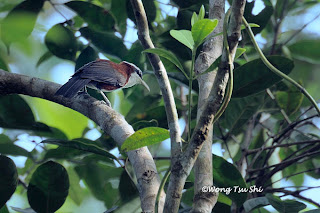The next morning was greeted by the laud singing of this Rufous-crowned Babbler Malacopteron magnum As typical of all babblers, its picture proved to be a nightmare to take as the light was dark and it moved incessantly amongst the thick undergrowths near the restaurant. Rufous-crowned Babbler looks very similar to Scaly-crowned Babbler Malacopteron cinereum, however, the darkish legs confirm this as Rufous-crowned Babbler.
Rufous-crowned Babbler
This White-crowned Shama Copsychus stricklandii was perched in the open while looking for breakfast. White-crowned Shama is endemic to Northern Borneo, where it is replace by White-rumped Shama Copsychus malabaricus south of Sabah, and the range of these two species overlaps from Lawas to Sg. Padas in the West, and from somewhere between Sg. Sekatak and Talisayan in the East Kalimantan (Holmes and Burton 1987) to Danum Valley (Kiew 1977), Darvel Bay and the Semporna islands on the east. D. Wells (in Kiew 1977) noted a few specimens from Danum Valley have crown feathers tipped in black, suggesting hybridization among the two.
White-crowned Shama
A family of Smooth Otter Lutra perspicillata was swimming upstream along the Lipid River in search for fish.
Smooth Otter
This Nymph Butterfly was basking in the morning sun.
This Wallace's Hawk Eagle Spizaetus nanus must have caught a rat from the oil palm plantation, it was well hidden among the leaves on this tall tree. There could be a nest with chicks somewhere near here as it flew away with its prey tightly in its grasp.
Wallace's Hawk Eagle
A family of Bornean Gibbon Hylobates muelleri was feeding on young shoots at the canopy quite a distance away. Bornean Gibbons are endemic to Borneo, dwell in the lowlands and hills, up to 1,500 m on Mt. Kinabalu, usually found in small groups of one adult male, one adult female and up to three young. Bornean Gibbons are often heard as their unmistakable laud calls can be heard miles away in the forest, however, as they dwell on tall trees they can be difficult to spot and even harder to photograph.
Bornean Gibbon
I took the above two pictures with my DSLR and my 600mm lens and the following picture with my compact camera. The primate is almost impossible to discern in the following picture, so length does make a lot of difference.
We continued along the road and this Indian Black Eagle Ictinaetus malayensis flew overhead.
Indian Black Eagle
We carried on and saw a bird hopping along the road, from a distance we thought it was a Yellow or Grey Wagtail, but decided against it later as it did not have the characteristic white outer tail feathers of a Wagtail. So we stopped the car to investigate, and very much to our delight we found it to be a different bird and another lifer for me (#295), the Eyebrowed Thrush Turdus obscurus. When migrating this bird can be found both in the lowlands and montane forest in Borneo, we saw a number of them foraging along the road in Tabin on that day.
Eyebrowed Thrush
Verditer Flycatcher
Its yellow belly and streaky throat and upper breast indicate that this is a Long-billed Spiderhunter Arachnothera robusta, another lifer for me (#296). A Streaky-breasted Spiderhunter Arachnothera affinis would show greyish belly and the similar looking Grey-breasted Spiderhunter Arachnothera modesta does not occur in Sabah.
Long-billed Spiderhunter
This lone Williamsoni race Asian Brown Flycatcher Muscicapa dauurica was hunting from this perch far away. This much rarer Williamsoni race Flycatcher differs from the commoner Asian Brown Flycatcher by having broad streaky breast. The Williamsonni race is considered by some taxonomists to be a seperate species, called Brown-streked Flycatcher Muscicapa Williamsoni.
Along the road and we were alerted by the whistling sound from a stream nearby and we were jumping with joy to spot the White-crowned Forktail Enicurus leschenaulti, another lifer (#297). While it has been long recognized that there are two races of White-crowned Forktail in Borneo, the montane race (used to be E. l. borneensis) and the lowland race (E. l. frontalis). Now White-crowned Forktail is reserved for the lowland species while the montane species is now called Bornean Forktail Enicurus borneensis.(split by Moyel et al. 2005).
I have taken pictures of Bornean Forktails in Kinabalu Park, which look much larger and have longer tail then the White-crowned Forktail we saw here.
I have taken pictures of Bornean Forktails in Kinabalu Park, which look much larger and have longer tail then the White-crowned Forktail we saw here.
White-crowned Forktail
After lunch, we made a trip to Lipid Mud Volcano via Tomanggong Road. There were a few White-bellied Munia Lonchura leucogastra among the flock of Chestnut Munia Lonchura atricapilla feeding in the tall grass along the road. White-bellied Munia are much rarer than Chestnut Munia, they are also very very skittish, will fly off at the slightest movement and sound. This shot was taken by hand holding my DSLR with the 600mm lens (without VR), glad that it looks acceptable.
The 700 meters trail from the Tomanggong Road to Lipid mud volcano was muddy and wet. However, Wellington boots provided by Tabin Wildlife Resort saved the day. The mud volcano is huge and more than 10 feet tall, as nothing grow on it so the area provides open and unobstructed view of all birds flying over the area.
White-bellied Munia
The 700 meters trail from the Tomanggong Road to Lipid mud volcano was muddy and wet. However, Wellington boots provided by Tabin Wildlife Resort saved the day. The mud volcano is huge and more than 10 feet tall, as nothing grow on it so the area provides open and unobstructed view of all birds flying over the area.
Lipid Mud Volcano
Lipid Mud Volcano, see its size with the human on it.
These Green Imperial Pigeon Ducula aenea were perched on a tree at the edge of the mud volcano.
Green Imperial Pigeon
Wreath Hornbill






















































